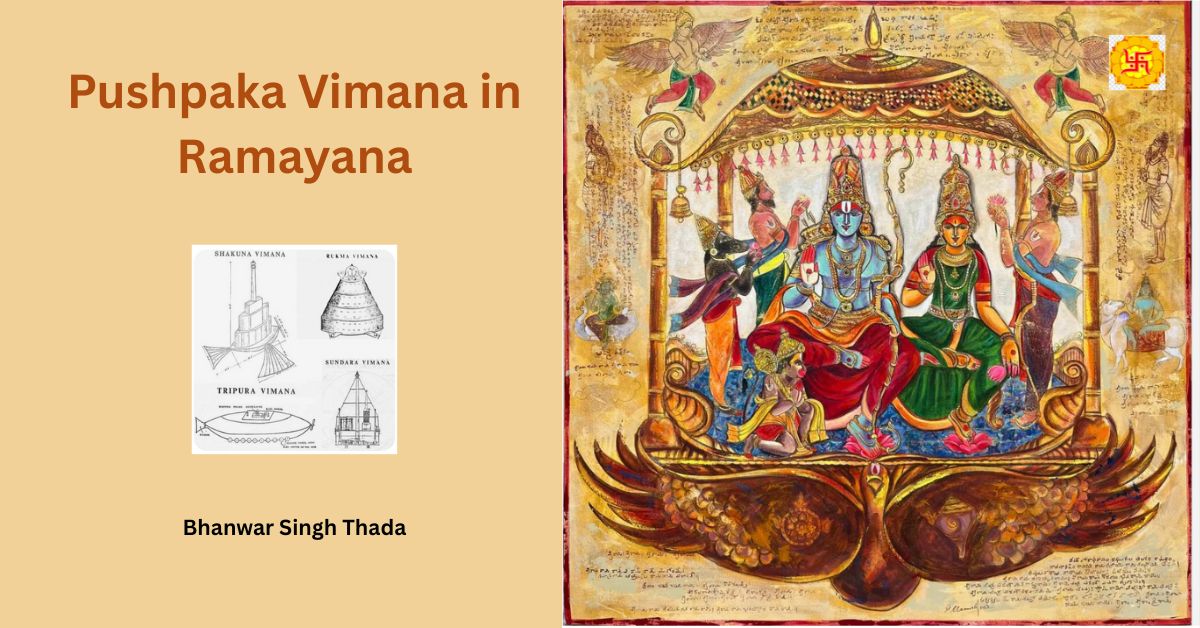The wonders of modern aviation often have their roots in the early 20th century-but ancient India took flight thousands of years earlier. Texts such as the sacred Vedas and the Ramayana describe the mystical Pushpak Vimana, a flying aircraft said to defy the limits of time and gravity. Beyond mere mythology, references to aerial vehicles, sophisticated propulsion, and aerial warfare suggest that ancient Indian aeronautics was far more advanced than commonly believed.
This article explores the truth behind the Pushpaka Vimana and the amazing aeronautical knowledge contained in India’s ancient texts.
Pushpak Vimana
The Pushpak Vimana, described in the Ramayana, has fascinated scholars, scientists and spiritual seekers for centuries. But do the Vedas mention flying machines like the Pushpak Vimana? Were ancient Indians familiar with aeronautics?
This article explores:
- Vedic and Puranic references to flying vehicles (Vimanas)
- Scientific interpretations of ancient aviation technology
- Spiritual meaning behind these descriptions
- Cultural impact of Vimanas in Indian history
1. Vedic References to Flying Machines
While the Pushpak Vimana is famously described in the Ramayana, earlier Vedic texts also mention aerial chariots (Rathas) used by gods:
Rigveda (1500-1200 BCE)
- Sun God’s Chariot: The Rigveda describes the Sun (Surya) traveling in a radiant flying chariot .
- Ashvins’ Flying Vehicles: The twin gods Ashvins possessed a three-wheeled, bird-like chariot capable of flight .
Yajurveda & Samaveda
- Mentions of celestial vehicles (Divya Rathas) used by deities like Indra and Agni.
Key Insight:
The Vedas use symbolic language-some scholars interpret these as metaphors for cosmic forces, while others see them as descriptions of advanced technology.
2. Pushpak Vimana in Ramayana & Puranas
The most detailed account comes from the Ramayana (3rd century BCE):
- Origin: Built by Vishwakarma for Brahma, later owned by Kubera, then stolen by Ravana .
- Features:
- Could expand or shrink in size
- Moved at the speed of thought
- Had self-navigation capabilities
- Rama’s Return: After defeating Ravana, Rama used it to return to Ayodhya, marking the origin of Diwali .
Mahabharata’s Vimanas
- King Vasu received a crystalline flying chariot from Indra .
- Arjuna traveled to celestial realms in a divine Vimana .
3. Vaimanika Shastra: Ancient Aeronautics Manual ?
The Vaimanika Shastra (early 20th century) claims to be an ancient text on aeronautics, allegedly channeled from Maharishi Bharadvaja .
Key Claims:
- Describes 25 types of Vimanas, including Pushpaka .
- Mentions mercury vortex engines, solar energy, and anti-gravity tech .
- Criticism: A 1974 IISc study dismissed it as pseudoscience .
Did Ancient India Have Flying Machines?
- Mythological View: Symbolic representations of divine travel.
- Alternative Theory: Lost ancient technology (like Egyptian or Mayan aviation myths).
4. Scientific & Spiritual Interpretations
Scientific Possibilities
- Hot Air Balloon Theory: Some suggest Pushpak Vimana was an early balloon .
- Advanced Metallurgy: Texts mention unbreakable alloys (Tamogarbha Loha) .
Spiritual Meaning
- Vimanas represent higher consciousness-symbolizing the soul’s journey beyond material limits.
- Metaphor for Meditation: Just as a Vimana ascends, yogis rise above earthly illusions.
5. Cultural & Historical Impact
- Diwali Connection: Rama’s return on Pushpak Vimana is celebrated as Victory of Light .
- Modern Influence:
- Bangladesh Biman Airlines derives its name from Vimana .
- Vimanapura (Bangalore) and Vimannagar (Pune) are named after these legends.
Conclusion
Today’s science considers airplanes and spacecrafts to be the greatest achievement of human civilization, but do you know that detailed descriptions of airplanes are found in Indian Vedas and Puranas thousands of years ago? The famous Pushpak Vimana of Ramayana is one such example, which even modern science looks at with surprise.
The history of Indian culture has been very rich not only from a spiritual point of view but also from a scientific point of view. Whenever there is a discussion of ‘plane’ or ‘aircraft’, the name of ‘Pushpak Viman’ described in Vedas, Puranas and epics automatically comes to mind. In the modern era, many scholars have done research on this subject.
FAQs (People Also Ask)
1. Is Pushpak Vimana mentioned in the Vedas ?
No direct mention, but Vedic gods use flying chariots, which may be precursors.
2. Did Vimanas really fly ?
No archaeological proof, but texts describe them in detail-possibly allegorical or lost tech.
3. What is Vaimanika Shastra ?
A controversial text on ancient aeronautics, debated by scholars.
4. How did Pushpak Vimana work ?
Described as self-moving, thought-controlled, possibly using mercury propulsion .
5. Is there modern research on Vimanas ?
Some studies explore ancient aviation claims, but mainstream science remains skeptical.
References:
- Wikipedia – Vimana
- Encyclopedia MDPI
- Robometric Sagi – Pushpaka Vimana
- Vedveer Arya’s Research
- “Ravana’s Aircraft” (Scientific Analysis)
Read Also –

1 thought on “Pushpak Vimana in Vedas: The Truth About Ancient Indian Aeronautics”